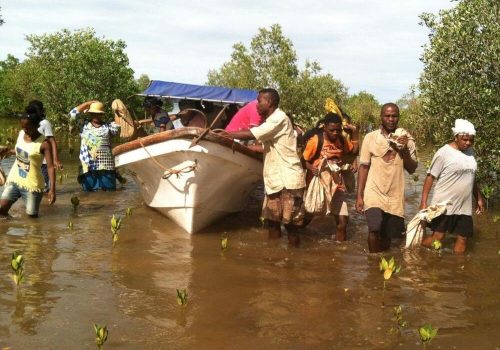
Andy Dowds
Co-Founder
I’ve always loved trees. Ever since my old teacher Mrs McGuigan cast me as one in a school play when I was six.
I was a good tree. A very good tree. Everybody said so. My Mum. My Dad. Everybody.
That was 24 years ago. Now I’m 30 (and it feels like I’m going to bed earlier than I did back when I was a wee tree) and I’ve just co-founded my very first company.
This company.
Alter Eco.
And I help plant trees for a living.
It’s all come full circle.
We plant trees in partnership with Eden Reforestation Projects, one of the coolest companies in the world.
Specifically, we help plant mangroves.
Globally, mangrove forests can be found on the saltwater coasts of 118 tropical and subtropical countries, totalling more than 85,000 square miles (Or 137,000 square kilometres if you don’t measure things the British way)
That’s nearly the size of the whole of the U.K.
They’re most common in Indonesia, Brazil and Malaysia.
And the mangrove is the Dustin Hoffman of trees.
It’s versatile.
They absorb four times more carbon than rainforest.
They protect coastal communities from tsunamis and storm surges because they reduce wave heights by up to 60% and and reduce tsunami flood depth by 30%.
They’re crucial nurseries for young fish, shrimp and crabs.
They prevent soil washing downriver into the ocean and destroying coral reefs.
The list goes on.

Eden Reforestation Projects have planted over 200 million of these wee beauties since 2006.
And now we’ve partnered with them too and we’re gonna add to that number.
Big time.
But there’s another side to this mangrove story.
They create jobs.
Lots of jobs.
Eden Reforestation Projects employs over 1000 local people to plant mangroves.
These workers are trained to gather and plant seeds from mangroves.
These seedlings are planted in the mud in saltwater where they thrive.
Mangroves are the only species of tree in the whole world that grow in saltwater like this.
At most planting sites, the two-week tide cycle contains a six-day window when planters can canoe into the mangroves, plant seeds and catch the outgoing tide before they get stranded on the mudflats at low tide.
Which means the mangrove-planters must work quickly and skilfully if they’re to get the job done right.
And that’s exactly what they do.
All trees are amazing.
But the mangrove is something special. A ‘belter’ as we say in Scotland.
And it could very well play a big role in the future of our planet.
Not bad for something that starts off so small it fits in the palm of your hand.
Reminds you that big change can come from small things and humble beginnings…
Something that’s all too easy to forget in the world today.
We all have the power to make a difference.
And the mangrove proves it.
Right, I gotta go. My fiancée is teaching me to cook Peanut Slaw with Soba Noodles and believe me when I tell ya I’m no Gordon Ramsay in the kitchen.
I could burn salad. But that’s a story for another time.
Wish me luck…






